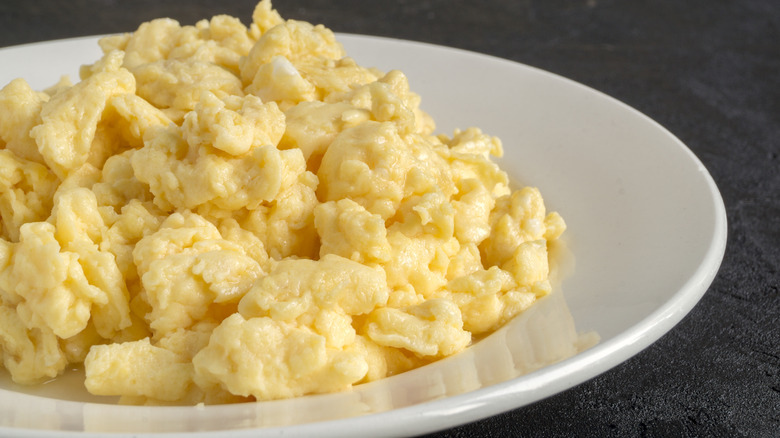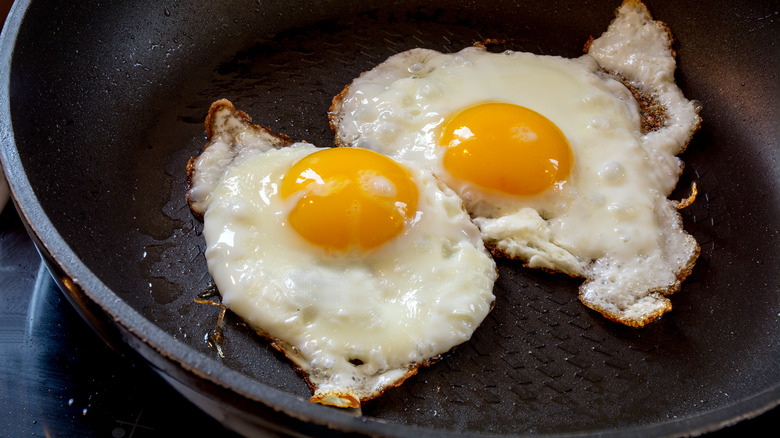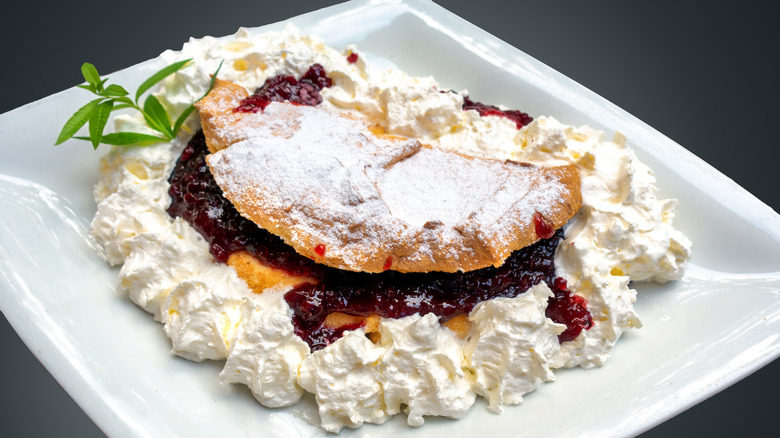The Sweet Secret Ingredient Ancient Romans Used In Scrambled Eggs
There are about as many ways to make "perfect" scrambled eggs as there are egg layers in Iowa (about 54 million, the last time they counted their chickens). Most of these scrambled egg hacks involve adding special ingredients to the eggs, which is a subject some never tire of debating. Should you stir in cream for added richness, or make the eggs light and airy with a splash of seltzer? Soy sauce adds an umami boost, while avocados, bacon, cheese, and other ingredients can take your eggs the rest of the way through the culinary alphabet. While the late Queen of England's preference for eggs with nutmeg and lemon zest was seen as being somewhat unorthodox by some, an even less familiar scrambled egg add-in is one that was popular back when the Roman Emperor Tiberius sat on a throne of his own.
A type of omelet topped with honey is featured in "De Re Coquinaria," a cookbook thought to be compiled by first-century foodie Apicius. It goes by the name ova spongia ex lacte, meaning spongy eggs with milk. This combination is hardly unusual, although the proportions are more liquidy than a modern omelet — for 4 eggs, you use a cup of milk as well two tablespoons of oil. Beat these ingredients, then cook the eggs (some translations say fry, others say bake) in more oil. When the ova spongia's done, top it with black pepper and honey, then do as the Romans do and dig in.
Honey with eggs isn't just a historical curiosity
The idea of serving scrambled eggs with honey still has its modern-day adherents, as well. One Reddit thread, despite being poster in r/unpopularopinion, found that few were shocked or revolted by the OP's admission that they enjoyed their eggs with honey. Some experimental chefs have even come up with their own spin on this first-century innovation. Quite a few of them lean into the sweeter side of such scrambles by using honey in combination with fruits and nuts such as peaches, bananas, and almonds. In fact, a traditional Polish dish called biszkoptowy is a kind of a cross between a sponge cake and an omelet and it's typically topped with a mixture of honey, cooked berries, and crème fraîche.
Other cooks, however, go sweet and savory with their eggs. One way is to scramble them with honey and cheese: Goat cheese provides a tangy counterpoint to honey, while feta's mild saltiness makes for a slightly subtler contrast. Still others eschew the cheese in their honied eggs and go for garlic, instead. Lui Coffee, a cafe in Georgia – the country, not the state — features one of the more over-the-top scrambled egg dishes we've seen on a restaurant menu. Theirs is made with a five-cheese blend (cream cheese, gouda, blue, parmesan, and a local specialty called suluguni) plus lettuce and roasted walnuts in addition to honey.
Other egg and honey dishes dates back a while
Ova spongia isn't the only honey egg recipe attributed to Apicius. He is also credited with a recipe for sliced boiled eggs dressed with a sauce made from pine nuts, vinegar, pepper, lovage, and honey as well as a sprinkling of the fermented fish sauce known as garum. A more modern Chinese dish that also involves boiled eggs and honey is known as sweet and spicy eggs. Here the eggs are also boiled, then quartered, dipped in batter, and deep fried. The honey-based sauce that accompanies them gets some kick from chopped chiles, ginger, garlic, and onions as well as saltiness from soy sauce and acidity from lemon juice.
While Apicius may have been the first historical personage we're aware of who ate his eggs with honey, he wasn't the last. Albert Einstein, whose ground-breaking theory of relativity revolutionized physics in the early 20th century, is alleged to have enjoyed breakfast eggs fried in butter and honey. A very similar dish known as huevos fritos con miel (fried eggs with honey) is known in Colombia.
Jelly with eggs is also a thing
While the ancient Romans may have endorsed honey with eggs, a modern-day breakfast chain behemoth comes out in support of a different sweetener: Chick-fil-A's own Chicken Wire blog suggests spreading strawberry jelly on its egg white grill. Other breakfast sandwiches, too, can benefit from a scoop of jelly, which is an idea that even chef Jose Andres can get behind (as per a 2019 tweet).
Even sans sandwich, though, jelly and eggs actually don't make such odd bedfellows (or pan-mates, as it were) as you might think. There are several different recipes for plain omelets filled with jelly that date back over a century, while the C&O railroad's dining cars were said to serve a similar dish in the 1950s. Redditors on a r/AskFoodHistorians thread seemed to think these omelets might be a New York/New Jersey thing, which is borne out by the fact that such an omelet was once featured on the menu of a Brooklyn diner called Green Pavilion (although it no longer seems to be available, more's the pity).



